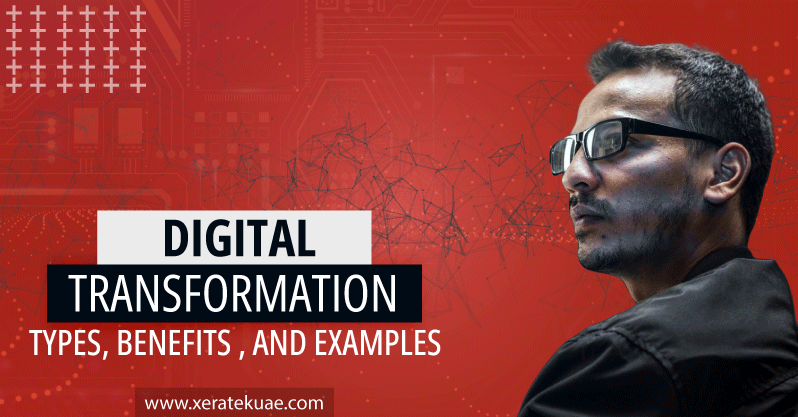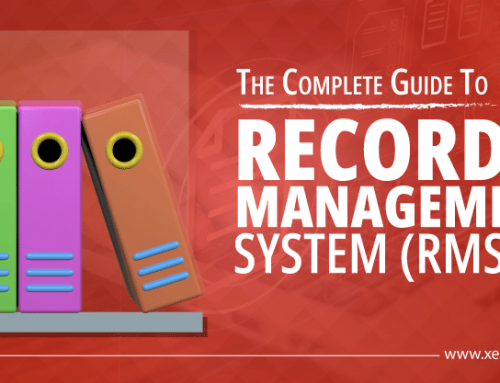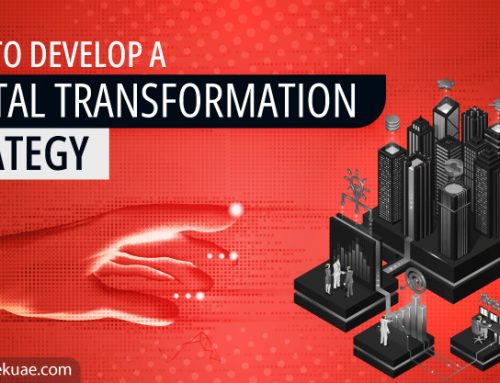Digital transformation is a hot topic that has been under discussion for the past few years worldwide. You should know about digital transformation, its types, benefits, and examples; start thinking about it if you run a business. You must know everything about digital transformation to take your company above your competitors.
This article will explain everything there is to learn about digital transformation.
What is Digital Transformation?
Digital transformation means optimizing business methods to drive potential growth while competing with the existing market. You may hear different definitions of digital transformation from different organizations because businesses vary in terms of services and markets.
Digital transformation (DT) can have different meanings for different businesses. However, you should be clear about your business vision and goals. Transformation starts with defining the roles your customers, partners and employees expect from you.
Therefore, every small or big organization must emphasize understanding the digital transformation concept and its approaches before starting this journey. It is extremely important to make a positive impact on the performance of your business.
Companies have realized the importance of digital transformation to achieve their goals more effortlessly.
Essential Elements of Digital Transformation
Although each organization is different and comes with uniqueness based on industries, businesses, and cultures, the meaning of transformation is not just replacing the old methods.
To understand the concept of digital transformation, you must know the essential elements that play a key role in the whole process.
1) Humans:
Everything is done by people for people. Similarly, digital transformation also starts with the people. It refers to people’s access to their clients, consumers, and employees. If you are running a small business, you may know what your clients are and what they want. Even a waiter knows about the likes and dislikes of their regular customers. But, things get more complex when your organization becomes larger, and you cannot easily manage your customers and employees. That’s where you will need digital transformation.
2) Data:
For digital transformation, you will need data to scale the knowledge of your employees or clients and replicate it in big organizations. The data must be easily accessible and retrievable. At this point, technology has a significant impact. So, this process of retrieving data and making digital records of people, specifically who they are and what they do or prefer, etc. It is generally known as datafying human behavior, which makes it much easier for businesses to work efficiently.
3) Insights:
Data is referred to as oil because we clean, refine and use it for various purposes, just like oil. You need a model, system, reliable data system, and a well-structured framework to make use of the data you have. You can turn data into insights with the right expertise and tools. That’s where technology comes in handy for analytics, helping you give meaning to the data. You can easily draw the graph and predict upcoming trends with the right, refined, and meaningful insights.
4) Action:
After knowing the meaningful insights, you will have to take action based on them. The most captivating insights will be wasted if you don’t have the right action plan. Therefore, you need a solid plan at this stage. It is always up to humans to figure out how and what to do with the prediction. Even if you have the best AI tools, data science, or analytics, you can’t do anything unless you have the right plan.
As a leader, you must know how to change your process and make decisions based on your insights. You will get predictions from AI and insights from data, and now you are at the point where you need to take action. Therefore, you must have the relevant skills and knowledge to take action.
5) Outcomes:
After taking actions based on insights and predictions, you are now at the stage to evaluate results and impact. It is not the final stage because, after evaluating the result, you will have to go back to the data. It is the new beginning of refining your digital transformation while learning from the findings of the previous stages.
It is an iterative process that will allow you to enable your insights to be more meaningful, predictive, and valuable. So, the results will also help you enhance your skills, which are a must to boost the synergy between the latest tools and humans.
Types of Digital Transformation
Different types of digital transformation offer various elements to help your business.
1) Business Process Transformation
Changing the business process through innovation impacts the internal working of the organization. It also affects how the company’s employees access the latest technology for regular work. It also includes automating manual processes and increasing marketing and R&D investments by using data to make decisions.
The primary goal of business process transformation is to reduce costs. Other objectives involve
- Improving the product and service quality,
- Minimizing the time to market, and
- Enhancing customer experience and brand image.
2) Business Model Transformation
Business model transformation is the type that changes the models to adapt to trending digital environments. It needs thorough consideration of how the industry and its business operations. Even a successful change can affect the whole industry, for example, Amazon for retail and Netflix for home videos.
This type of digital transformation covers the strategic phase of the business to find new potential ways of doing successful business. It primarily focuses on innovation while thinking out of the box.
3) Domain Transformation
The main goal of domain transformation is to transcend conventional methods, considering the possibilities and the brand’s market. Amazon, an online retailer, launched AWS, the largest cloud computing services provider. Amazon utilized its current capabilities to work on new possibilities and create a new market.
You can see many industries where domain transformation has huge potential. However, you can successfully transform domains if you use AI and the latest technology, like IoT, in the right way.
4) Cultural Transformation
Culture plays a critical role in the success of any business. However, cultural transformation can be unexpectedly challenging for most organizations. Therefore, it is suggested to start digital transformation by educating the existing staff, ensuring everyone understands the importance of new tools and technology to improve the business, creating a process of consistent innovation, and forging internal cooperation.
You need a workforce to leverage technology and continuous innovation. That workforce must be able to adapt to new changes and be willing to learn and grow.
5) Cloud Transformation
Cloud digital transformation allows organizations to update information systems to cloud services. It may have many shapes, such as a company can only migrate particular applications, services, or data and retain the legacy. You can move the whole infrastructure to the cloud.
Another important element in cloud transformation is ownership. Some companies prefer the public cloud, where a third party will host your services or websites. In private cloud services, you can set up your cloud servers in-house. Combining both is called hybrid cloud services.
Difference Between Digitalization and Digital Transformation
You may have already come across digitalization, digitization, and digital transformation. The fact is that they are different from each other and have different meanings. Let’s see what common differences are there between them.
Digitization means transforming information from physical documents to digital ones. (Learn more about document digitization).
Digitalization is the process of utilizing digitized data or information in work to achieve specific goals simply and efficiently. In the current world, digitalization has great importance for any business to thrive.
Digital Transformation is a term used to switch how we conduct our regular businesses. It is more about taking steps backward and revisiting all things you do. It could be reviewing the internal systems and electronic signatures to customer services. However, the main key or focus of digital transformation is to realize the ultimate potential of the technology you use.
Benefits of Digital Transformation in Business
Digital transformation only benefits your business to thrive in this fast-paced digital world. According to the survey, DT increases operational efficiency by 40%, quicker time to market by 36%, and meeting customer needs effectively by 35%. Another research shows that digitally-equipped organizations generate more profit by 23% than their competitors with less digital awareness.
Let’s have a look at some of the top benefits.
1) Accelerating Business Operations with Automation
Automating tasks that take a lot of time for employees is considered the most significant advantage of DT. The software can easily perform tasks requiring the staff’s focus and time. With digital transformation, you can automate manual processes such as sending emails about updates, gathering customer information, invoicing, procurement tasks, and payroll. You will agree that these processes take a lot of time.
Transforming your business processes is a foundational stone. It does not even cost much because of the software solutions that help organizations reduce their investment risks.
2) Enhancing the Customer Experience
According to Forbes, the percentage of leaders who improve their consumer experience using digital transformation is surprisingly 92%. Yes, you can improve the customer experience to the highest level by promoting digital transformation in the business.
You can automate the process of replying to customer queries. Moreover, DT allows customers to access your services using the methods they like to interact with you. So, they can contact you with multiple options such as live chat, phone, email, support forum, and mobile app. Since all these channels will be digital, it gives your customers various touchpoints. Moreover, they can track their tickets easily using their dashboard. Hence, digital transformation will help your consumers access services hassle-free.
3) Fine Decision-Making Based on Data
Digital transformation allows you to see what works well and which areas need improvement. Hence, it gives you greater visibility to decide based on the data. Digital tools are made to collect and process information, allowing you to recognize patterns and look for improvement opportunities.
You can build a data center to store data and use it to check your employee’s performance, consumer behavior and preferences, and much more. Your reporting abilities will increase once you successfully implement digital tools to enhance your business processes through digital transformation.
There will be no need for manual feedback, surveys, or sampling. You can always access the data you need to make decisions.
4) Excellent Flexibility, Agility, and Scalability
It is also one of the top advantages of digital transformation. In the current world, you need to break the legacy and try out innovative and available alternatives to boost your business. This is what digital transformation is all about. Most businesses still follow old methods and technologies. You cannot scale the manual processes with an increasing number of customers. So, you need something to work with.
Modern software solutions make integrating multiple areas of the business easier and minimize mistakes. Once a task is completed successfully, your solution can easily connect the data for the next task. Everything can be done without any manual help. It shows that digital transformation can help organizations to be more agile and responsive to customers’ preferences, which are constantly changing.
5) Reliability and Security
With the consistent expansion and growth of organizations worldwide rapidly, the technology they have been following may not be enough. It is costly and difficult to back up, maintain and secure data in old systems. Moreover, old technologies and systems can easily be attacked by hackers.
According to the report, 49% percent of organizations have opted for digital transformation because of secure customer data. It minimizes security risks to a great extent.
In another report by McKinsey, advanced digital risk solutions can easily reduce the operating costs of activities by 20-30%. So, upgrading to the latest tools through digital transformation will make your services more reliable and data secure.
Examples of Digital Transformation
Popular examples can always help people understand the benefits of digital transformation and how it helps businesses achieve specific goals. It also helps in learning from the challenges. Downfalls and competitor success. So, the following examples will help you determine what you need to focus on if you want your business to accelerate.
Digital transformation has been opted for by different industries, starting from moving operations from analog to digital.
Let’s look at a few popular digital transformation examples.
a) Adobe Company
You may already know about Adobe, an American company that offers popular products such as Photoshop, Acrobat Reader, and Illustrator. The company faced a crisis in 2008, and they had to make decisions. So, they start a subscription model instead of a license-based model.
Redefining the services, they started three cloud-based services, Document Cloud, Creative Cloud, and Experience Cloud. This is how they got themselves out of the crisis and became a popular SaaS model company. Since then, they have incorporated the latest digital tools to regularly enhance the quality of the services for their customers.
b) Porsche – Customer Experience
Customer is the most important element of any business, right? So, prioritize improving the services for them. Porsche, a renowned car manufacturing company, has followed this approach, putting their customers first. Their digital strategy is driven by customer experience.
They have invested a lot of money to understand the Porsche driver. So, they followed an approach where they put their customers’ data into a central data center, documenting each customer interaction. This data has helped them with predictive intelligence and real-time segmentation. The results were brilliant as they only contacted people who would buy their cars.
c) Connected Enterprise | Rockwell Automation
Rockwell Automation has achieved great milestones in pursuit of becoming a connected and organized enterprise in the future. The leadership has made some impressive decisions. They follow the top digital transformation strategies currently, such as becoming the best company to enhance customer experience and to achieve all business goals of the connected enterprise.
They have been doing an excellent job in making things up-to-date with the latest digital transformation regarding the connected enterprise.
d) Buying Other Firms | Disney
Disney has acquired different companies to meet the needs of its customers and put their preferences first. Various customers have different needs and want video streaming enabled by the latest technology. So, the company has bought BAMTech and many other companies to connect directly with customers.
This is the best example of advanced digital transformation.
How Xeratek Powers Digital Transformation
Xeratek helps small and large organizations with their digital transformation services to survive longer in the future. We help organizations optimize internal processes and enhance customer experience using the latest digital tools to ensure smooth working. If you are looking for an expert team to kick off a digital transformation, get in touch with us!
Digital Transformation FAQs:
What is digital transformation?
Digital transformation is the optimization of business models to drive the potential growth of the organization.
What are the core elements of digital transformation?
The core elements of DT include User, Data, Insights, Action, and Outcomes.
What are the types of digital transformation?
The four types of digital transformation are Business Model Transformation, Domain Transformation, Cultural Transformation, and Cloud Transformation.
What is the difference between digitalization and digital transformation?
Digitalization is developing processes and changing workflows, whereas digital transformation is the ability to quickly adapt when needed through technology and tools.






